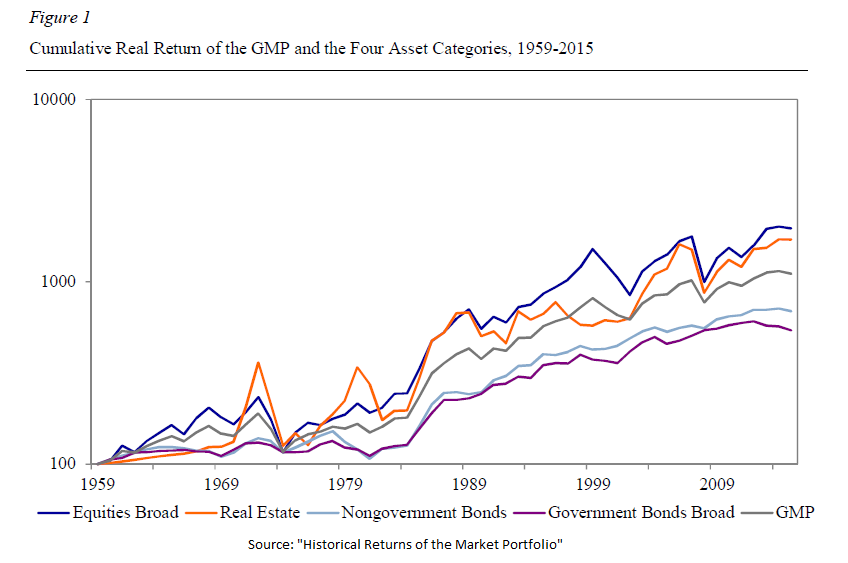The market portfolio, in theory, is a simple concept. Buy and hold everything in market-value weights. But the road from concept to implementation is rocky. Some asset classes are relatively illiquid and therefore difficult to own directly. There’s also debate about how to estimate weights. Minds, in other words, will differ on devising a market portfolio benchmark for use in investment analytics and/or real-world investing. And now there’s one more perspective to consider, thanks to the arrival of a new entry in this niche: “Historical Returns of the Market Portfolio” by Ronald Doeswijk, an independent researcher, and two co-authors.
One of the paper’s selling points is the comparatively long history of the global market portfolio (GMP), as the authors label their index. With a start date of 1960, and a historical window for profiling what is considered the gold standard of investment benchmarks.
Regular readers of The Capital Spectator know that a comparable effort at quantifying the market portfolio is a staple on these pages, including the monthly updates of the Global Market Index (GMI), an unmanaged benchmark that holds all the major asset classes in market-value weights. The limitation of GMI is that it only dates to 1997. GMP, by contrast, extends the history of Mr. Market’s portfolio by nearly four decades.
“Historical Returns of the Market Portfolio” is worth a close read, but as a teaser let’s pull out a few highlights, starting with the annualized return for the sample period. The authors report that GMP earned an annualized 8.4% for 1960-2015 – a handsome premium over GMI’s 5.6% for 1997 through June 2017. The implication: the market portfolio’s performance tends to be higher over longer periods relative to track record of the past 20 years.
What accounts for GMP’s higher return? Perhaps it’s due to design rules, which differ from GMI’s. GMP’s longer history may be a factor too.
Adjusting performance for inflation, the authors note that “the real return for the GMP is relatively flattish in the first part of the graph, while at the latter part it is also not steep.” In other words, GMP’s strongest performance period was roughly 1980-2000.
Meanwhile, GMP’s risk (annualized volatility) is 11.5%, which is also higher than GMI’s 9.8% vol. GMP’s Sharpe ratio is higher too: 0.69 vs. 0.57 for GMI. In this comparison, at least, higher risk translates into higher return in absolute and risk-adjusted terms.
The paper’s main takeaway: investing across a broad set of asset classes has earned a competitive, perhaps superior return vs. the usual suspects. Does that mean that your investment portfolio should approximate GMP? Probably not. In theory, GMP (or GMI) is the optimal portfolio for the average investor with an infinite time horizon. By definition, that excludes almost everyone, save for a handful of institutional investors.
Nonetheless, a robust benchmark is essential for analytical and design purposes, and the likes of GMP (or GMI) fit the bill to a tee. What’s the relevance? Context. The first step for portfolio design is deciding how (or if?) to customize Mr. Market’s asset allocation to match a specific investment objective, risk tolerance, etc. There are no easy solutions, but at least we know where to begin this analytical journey.

